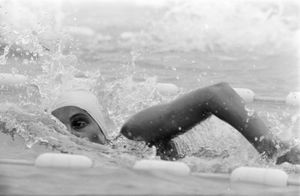Swimming Overuse Injuries: Difference between revisions
(added original editor and templates) |
(text, media) |
||
| Line 9: | Line 9: | ||
</div> | </div> | ||
== Introduction == | == Introduction == | ||
Swimming is a great sport enjoyed by all age groups at all levels of ability. It combines body strength, flexibility, and endurance. Swimmers are unfortunately prone to injuries. Most swimming injuries are classed as overuse injuries and relate to faulty biomechanics The most common swimming injury regions are the shoulder, neck, lower back, and knee. | |||
[[File:Swimmer.jpg|right|frameless]] | |||
Swimming overuse injuries usually arise from one or a combination of the below | |||
* Poor stroke mechanics | |||
* Poor breathing technique | |||
* Poor flexibility or range of motion eg of neck or low back | |||
* Hyper flexibility of joints with insufficient muscular stabilisation | |||
* Decreased rotator cuff or scapular muscle strength | |||
* Insufficient core strength/stability | |||
* Decreased hip muscle strength | |||
* Overtraining | |||
* Not enough rest periods | |||
== Sub Heading 2 == | == Sub Heading 2 == | ||
| Line 25: | Line 37: | ||
<references /> | <references /> | ||
[[Category:Sports Injuries]] | |||
[[Category:Shoulder - Conditions]] | |||
[[Category:Knee - Conditions]] | |||
Revision as of 07:26, 11 September 2019
This article or area is currently under construction and may only be partially complete. Please come back soon to see the finished work! (11/09/2019)
Original Editor - Your name will be added here if you created the original content for this page.
Top Contributors - Lucinda hampton, Kim Jackson, Wanda van Niekerk, Jacob Bischoff and Mohit Chand
Introduction[edit | edit source]
Swimming is a great sport enjoyed by all age groups at all levels of ability. It combines body strength, flexibility, and endurance. Swimmers are unfortunately prone to injuries. Most swimming injuries are classed as overuse injuries and relate to faulty biomechanics The most common swimming injury regions are the shoulder, neck, lower back, and knee.
Swimming overuse injuries usually arise from one or a combination of the below
- Poor stroke mechanics
- Poor breathing technique
- Poor flexibility or range of motion eg of neck or low back
- Hyper flexibility of joints with insufficient muscular stabilisation
- Decreased rotator cuff or scapular muscle strength
- Insufficient core strength/stability
- Decreased hip muscle strength
- Overtraining
- Not enough rest periods
Sub Heading 2[edit | edit source]
Sub Heading 3[edit | edit source]
Resources[edit | edit source]
- bulleted list
- x
or
- numbered list
- x







